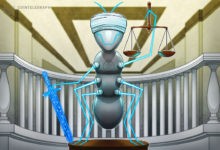See You on the Otherside: How Yuga Labs Is Bringing Its Billion-Dollar Business Into the Metaverse

If you’ve been on Twitter over the last two years you’ve likely come across an influencer or celebrity sporting a Bored Ape Yacht Club profile picture (PFP). The colorful cartoon ape non-fungible tokens (NFT) have become something of a cultural phenomenon since launching in April 2021, functioning as a status symbol forcollectors of the 10,000-piece digital art collection.
Though some may roll their eyes at the collection’s lowbrow art style and fervent worship among the Twitter degens, the project combined several novel concepts – including publishing a road map, minting at a fixed price, introducing long-term utility and handing intellectual property (IP) rights to holders – that transformed the NFT market and became the blueprint for new projects. It has also spawned two successful offshoot projects (Bored Ape Kennel Club and Mutant Ape Yacht Club) and has grown from an NFT collection to an entire ecosystem, complete with its own decentralized autonomous organization (DAO), cryptocurrency and a soon-to-be-launched gamified metaverse platform called Otherside.
To understand BAYC’s success is to understand the leadership team behind it and the blockchain technology company, Yuga Labs, that powers all of its endeavors. Originally conceived by close friends Wylie Aronow and Greg Solano, who called in an A-team of college friends and childhood connections to bring the project to life, Yuga Labs has grown its staff to 110, expanded its portfolio of brands to include NFT projects CryptoPunks and Meebits and was valued at $4 billion earlier this year following a $450 million funding round.
On Dec. 19, the company announced that former Activision Blizzard President and Chief Operating Officer Daniel Alegre would be stepping in as its new CEO, bringing with him expertise in gaming that will help merge all of Yuga’s passionate collector communities and shift its focus toward building an «immersive Web3 world.»
«That’s the ultimate for us,” Aronow told me during an interview at the Institute of Contemporary Art in Miami, where the startup founders were celebrating CryptoPunk #305 being placed next to an Andy Warhol portrait on the wall of the museum. «We see Otherside as the intersection of a lot of this stuff and where we see really the next evolution of the space going towards, where gaming is so important,» Solano added.
Founder foundations
Aronow and Solano are the creative drivers of what they call a «creative-first company.»
«Our DNA is that we think of the things that we want to do and then figure out the creative stories that we want to tell,» Solano told me. «Then we figure out how we’re going to do them and work back from there.» He and Aronow both have backgrounds in creative writing, showcased through BAYC’s use of narrative-driven storytelling to create an entire universe around their characters. Aronow told me that despite their differences in personal taste and personality («I’m extroverted, he’s introverted,») the duo has learned how to find common ground, playfully calling their relationship «co-dependent.»
«We have this extreme yin and yang thing going on,» Aronow said. «He pushes me, I rein him in and we find a spot where we’re aligned,» Solano added.
In addition to literature, the two men are both avid gamers who initially bonded over a shared love of MMRPGs (massively multiplayer role-playing games) like World of Warcraft some 12 years ago. «It was mostly just trading books and making jokes,» Aronow said of their early relationship. In fact, Aronow and Solano spent much of their budding friendship communicating through online games and social platforms, instilling in them an appreciation for and a deep understanding of digital meeting spaces. «[Before BAYC], we met in person maybe only four or five times,» Solano said.
«Our friendship was born in the metaverse, I guess you could say,» Aronow joked.
Creating a project for the degens
Making the jump from crypto enthusiasts to founders of a multi-billion-dollar company was the combination of good planning and good timing.
A mutual interest in Ethereum grew as crypto began to spike in the late 2010s, inspiring the two friends to create a blockchain-based project together. They recruited Solano’s college friends Kerem Atalay and Zeshan Ali, who helped to co-found Bored Ape Yacht Club, alongside Aronow’s childhood best friend Nicole Muniz, who has served the company’s CEO and will shift into a role as partner and strategic adviser when Daniel Alegre takes over as CEO next year.
«The first time you hear about crypto is because someone probably casually mentioned it and you don’t know what to make of it,» Aronow said. «And then the second time you hear about crypto is probably the most important time because the person who told you the first time has now made a lot of money off it.»

Yuga Lab’s leadership team: Zeshan Ali, Kerem Atalay, Nicole Muniz, Greg Solano, Wylie Aronow (Matteo Prandoni/BFA.com)
Aronow had been dealing with an autoimmune condition for several years, which led him to seek social interactions and community online. The pair soon became active on Crypto Twitter – aka the corners of Twitter where communities of crypto enthusiasts share market movements and memes – and were fascinated with what they saw as an emerging social movement around NFTs and Ethereum.
«We became interested in the personalities and the culture that was being built on crypto Twitter and, in particular, around Ethereum. It just felt like there was suddenly a platform for people to build upon,» he said.
The COVID-19 pandemic, the co-founders said, helped to accelerate the process by bringing people indoors and pushing them to find new ways to collaborate in digital spaces.
«I think there’s no coincidence that we launched during the lockdown, and a lot of people were somewhat lonely at their computers, hanging out,» Solano said.
«We think a lot about the impact that COVID had on the creation of Bored Ape Yacht Club and why NFTs and the 10K profile picture collections boom took off,» Aronow continued. «I feel strongly that, for better or worse, human beings seem to do better with communal families or tribes. There was just a longing to be a part of a club.»
He shared stories of pseudonymous Twitter personalities tweeting late at night that they were bored and were looking for companions to play video games with. Combined with the affectionate term embraced by the crypto community of «aping» into a project with zeal, Bored Ape Yacht Club was born.
«All these folks who ‘aped’ into crypto at some point, who probably became rich in the scope of things,» Aronow said. «They just wanted to be among other people with shared interests.»
Ultimately, they say, while the project was crafted as a «loving homage» to the «degenerate traders» of the crypto ecosystem, many of their early community members were first-time NFT buyers who were learning alongside them. «There came this moment … where we realized that we were building it for ourselves rather than for anyone else,» said Aronow.
Scaling for growth
It wasn’t long before fine art purveyors, celebrity collectors and crypto millionaires swarmed to collect what had become one of the most sought-after NFT projects to date.
According to OpenSea, BAYC has done 699,831 ETH (about $844 million at the time of publishing) in total trading volume since launching, which doesn’t even count their offshoots the Bored Ape Kennel Club and Mutant Ape Yacht Club NFTs. This year, Yuga Labs also acquired several legacy NFT projects, including CryptoPunks, Meebits and 10KTF, propelling the company forward in ways the two co-founders say they weren’t initially prepared for.
«For a long time we were a small team, like in January of this year we were still 11 people,» said Solano. «We held on to being a very small, nimble team for maybe too long.»
Yuga Labs has released the IP rights of its collections to its holders, allowing NFT characters to be used on branding for food trucks, TV shows and music groups. This has created new revenue streams for holders and has fostered more brand loyalty. «We always talk about how we build the scaffolding for everyone else to sort of build on the story,» said Aronow. At this year’s ApeFest, the brand’s annual music and networking festival for BAYC holders, Solano shared that «it felt like almost everyone we met was building in space or was leveraging their IP.»
Bringing their community to the Otherside
In recent months, the two co-founders have been looking for ways to merge the narratives of all of their NFT brands into one shared ecosystem. In April, Yuga Labs announced the Otherside, a gamified, interoperable metaverse experience, where players could own land and turn their existing NFTs into playable characters. Yuga Labs sold 55,000 Otherdeed NFTs linked to virtual land ownership, raking in about $320 million in primary sales.
«All of the projects that we have are deeply important to us,» said Aronow. «Where we see the Otherside is at that intersection.»
In July, the brand ran an invite-only «First Trip» for over 4,600 players, giving the first glimpse at what their world-building platform would look like. In a litepaper released shortly after the event, developers said that in the initial stages, only Otherdeed holders and selected third-party developers would be able to participate in the «narrative gameplay experience.»
«In the future, we look forward to seeing what new experiences and games our community can create to expand the possibilities of the metaverse,» the litepaper teased.
The next stages of the Otherside metaverse remain shrouded in secrecy, though they are being built on the foundations of gaming and narrative-driven storytelling that initially brought the founders together. Yuga Labs has teased another possible character collection called Kodas that are embedded into Otherdeed NFTs and released a promotional video in September promising more storytelling by the end of this year.
Beyond an expansion of their brand, Aronow views the metaverse as a concept representing «nebulous determinism that might be a sort of like an endpoint for the Internet.»
«If we’re going to start truly inhabiting digital spaces around the clock, what does that look like? Is it going to feel egalitarian? Is it going to feel interoperable?»
«The idea of clocking into work in the metaverse in a really unfun way sounds hellaciously dystopian,» he added, calling the Otherside «a platform for gaming and weird experiences.»
It’s no coincidence that their incoming CEO helped oversee gaming titles including World of Warcraft while at Activision Blizzard – the same game that Aronow kept coming back to during our interview as a source of inspiration for the Otherside.
«We started thinking about how to incentivize cooperation,» Aronow told me of Yuga’s early metaverse ambitions. «In World of Warcraft, for instance, you could play the game as a mostly single player, but if you came across a big baddie in the swamp and you saw another player around … suddenly you’re incentivized to go up to that person and say ‘Hey, can you help me kill this thing? We’ll share the rewards.'»
Creating a «truly co-developed, egalitarian metaverse that is fun» is now Yuga’s «highest priority,» said Solano. «It’s really about encouraging people to work together and get to know each other.»
«It exemplifies … why we wanted to do this in the first place,» Aronow concluded.







 Bitcoin
Bitcoin  Ethereum
Ethereum  Tether
Tether  Dogecoin
Dogecoin  USDC
USDC  Cardano
Cardano  TRON
TRON  Bitcoin Cash
Bitcoin Cash  Chainlink
Chainlink  Stellar
Stellar  LEO Token
LEO Token  Litecoin
Litecoin  Hedera
Hedera  Cronos
Cronos  Ethereum Classic
Ethereum Classic  Dai
Dai  Monero
Monero  Stacks
Stacks  OKB
OKB  Cosmos Hub
Cosmos Hub  Algorand
Algorand  Theta Network
Theta Network  Maker
Maker  KuCoin
KuCoin  Gate
Gate  Tezos
Tezos  Polygon
Polygon  NEO
NEO  Zcash
Zcash  Tether Gold
Tether Gold  IOTA
IOTA  Synthetix Network
Synthetix Network  Bitcoin Gold
Bitcoin Gold  TrueUSD
TrueUSD  Zilliqa
Zilliqa  Holo
Holo  0x Protocol
0x Protocol  Dash
Dash  Qtum
Qtum  Enjin Coin
Enjin Coin  Siacoin
Siacoin  Basic Attention
Basic Attention  Ravencoin
Ravencoin  Decred
Decred  Ontology
Ontology  NEM
NEM  DigiByte
DigiByte  Lisk
Lisk  Status
Status  Waves
Waves  Nano
Nano  Numeraire
Numeraire  Pax Dollar
Pax Dollar  Hive
Hive  Huobi
Huobi  Steem
Steem  BUSD
BUSD  Ren
Ren  OMG Network
OMG Network  Bitcoin Diamond
Bitcoin Diamond  Bytom
Bytom  Kyber Network Crystal Legacy
Kyber Network Crystal Legacy